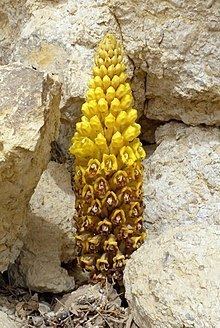Scientific name Cistanche Rank Genus | ||
 | ||
Lower classifications Cistanche deserticola, Cistanche tubulosa | ||
Cistanche stem famous herbal aphrodisiac and stalk enlarger
Cistanche is a worldwide genus of holoparasitic desert plants in the family Orobanchaceae. They lack chlorophyll and obtain nutrients and water from the host plants whose roots they parasitize.
Contents
- Cistanche stem famous herbal aphrodisiac and stalk enlarger
- Erica and cistanche flowers
- Uses
- Growth
- Research in laboratory animals
- References
Erica and cistanche flowers
Uses
Along with other members of the genus, Cistanche deserticola is the primary source of the Chinese herbal medicine cistanche (Chinese: 肉苁蓉, pinyin ròucōngróng). The main sources of cistanche are Cistanche salsa and Cistanche deserticola, although it may also be obtained from Cistanche tubulosa, Cistanche sinensis, and Cistanche ambigua. The drug, known in Chinese as suosuo dayun, is collected in spring before sprouting, by slicing the stems of the plant. Cistanche deserticola has been placed on CITES Appendix 2, a list of endangered species not banned from trade but requiring monitoring. With increased consumption of cistanche, the population of the species has decreased and its area of distribution has shrunk. Aside from over-collection or indiscriminate collection, an important factor in the diminished supply of cistanche is a loss of the saxaul host, Haloxylon ammodendron, which is widely used for firewood.
Cistanche has been used as a medicine for about 1800 years and is recorded in the Shennong Bencao Jing and Bencao Gangmu as a tonic. Most of the medicinal claims have never been evaluated through clinical testing, and those claims that have been examined under controlled medical study are not supported.
Growth
Growing in arid climates, cistanche is a parasitic plant that connects to the conductive system of a host, extracting water and nutrients from the roots of the host plant. Cistanche is native to the Taklimakan desert region of Xinjiang Uyghur Autonomous Region northwest China where it grows on host desert plants tamarix and haloxylon ammodendron.
Research in laboratory animals
A variety of pharmacological effects of extracts or chemical compounds isolated from different species of Cistanche have been reported in in vitro studies or in rodent models. The chemical constituents which may be responsible for these effects include acteoside, echinacoside, and cistanosides (A, B, C, D, E, F, G and H). These effects have not been demonstrated in humans.
Some of these effects include:
